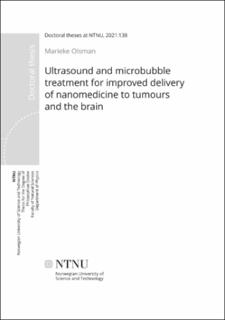| dc.contributor.advisor | de Lange Davies, Catharina | |
| dc.contributor.advisor | Andresen, Thomas Lars | |
| dc.contributor.advisor | Berg, Sigrid | |
| dc.contributor.author | Olsman, Marieke | |
| dc.date.accessioned | 2021-04-23T08:26:53Z | |
| dc.date.available | 2021-04-23T08:26:53Z | |
| dc.date.issued | 2021 | |
| dc.identifier.isbn | 978-82-326-5419-2 | |
| dc.identifier.issn | 2703-8084 | |
| dc.identifier.uri | https://hdl.handle.net/11250/2739276 | |
| dc.description.abstract | The combined use of ultrasound and intravascular microbubbles, referred to as ultrasound and microbubble treatment, has emerged as a promising technique to enhance delivery of nanomedicine to tumours and the brain. Even though the technique is on its way to the clinic, there are still various aspects to study and optimize to make ultrasound and microbubble treatment even more successful.
In this thesis we first investigated if ultrasound and microbubble treatment combined with nanoparticles exhibiting features to increase internalization by tumour cells upon ultrasound-mediated delivery would improve the therapeutic efficacy of the treatment. This was studied by combining ultrasound and microbubble treatment with liposomes coated with an enzymatic cleavable poly(ethylene) glycol (PEG) layer which upon cleaving may increase internalization of the liposomes by tumour cells and may destabilize the liposomal membrane resulting in accelerated drug release. For the enzyme sensitive liposome and the two types of control liposomes, ultrasound and microbubble treatment resulted in enhanced tumour accumulation, improved extravasation and increased tumour penetration depth of the liposomes. The therapeutic efficacy data indicated that the enzymatic feature of the liposome had a positive effect on the therapeutic efficacy, making it an interesting approach to increase the therapeutic efficacy of ultrasound and microbubble treatment.
Besides improving drug delivery to tumours, ultrasound and microbubble treatment can also be exploited to increase the permeability of the blood-brain barrier (BBB) by opening of tight junctions, creating endothelial cell openings and stimulating endo- and/or trans-cytosis. To exploit the different ultrasound induced transport pathways to the fullest, a high concentration of drug at the site of BBB disruption is favourable. By combining ultrasound and microbubble treatment with a liposome targeting the transferrin receptor on the BBB, it was investigated if this would enhance delivery of liposomes across the BBB compared to liposomes lacking the BBB-targeting moiety. The combined use resulted in a 40 % increase in accumulation of the BBB targeted liposomes whereas the control liposomes showed no increased accumulation. The results demonstrated that ultrasound and microbubble treatment may enhance endocytosis of the BBB-targeting liposomes which could be an interesting approach to enhance drug delivery to the brain.
The potential of Acoustic Cluster Therapy® (ACT), a microbubble platform specifically engineered for therapeutic applications, to increase the permeability of the BBB and enhance delivery of nanomedicine to the brain was also explored. Directly upon ACT, increased BBB permeability was observed and one hour post ACT a 5.2-fold and 3.7-fold increase in accumulation of a model drug and clinically relevant core-crosslinked polymeric micelles (CCPM) was detected, respectively. Confocal microscopy images of the ACT-treated brains verified the improved extravasation and penetration of the CCPM into the brain parenchyma. Histological analysis of brain sections revealed no treatment related tissue damage. With this study we demonstrated that ACT safely and transiently increases the permeability of the BBB and improves accumulation and distribution of nanomedicine to the brain.
ACT is expected to work by a different mechanism compared to conventionally used microbubbles such as SonoVue™. An intravital microscopy set-up to unravel the mechanism of action of ACT in the brain was therefore established with help of experienced collaborators. The surgical and technical procedures required to conduct in vivo multiphoton imaging simultaneously with ultrasound and microbubble treatment were described in detail.
To summarize, the work presented in this thesis has increased our understanding on how ultrasound and microbubble treatment can be used to improve delivery of nanomedicine to tumours and the brain. Even though there is still a lot to learn, the increasing number of (pre)clinical studies demonstrates that ultrasound and microbubble treatment could impact medicine by enhancing drug delivery and thereby improving and enabling treatment of various cancer types and several brain diseases. | en_US |
| dc.language.iso | eng | en_US |
| dc.publisher | NTNU | en_US |
| dc.relation.ispartofseries | Doctoral theses at NTNU;2021:138 | |
| dc.relation.haspart | Paper 1: Olsman, Marieke; Sereti, Viktoria; Andreassen, Kristine; Snipstad, Sofie; van Wamel, Annemieke; Eliasen, Rasmus; Berg, Sigrid; Urquhart, Andrew J.; Andresen, Thomas L.; Davies, Catharina de Lange. Ultrasound-mediated delivery enhances therapeutic efficacy of MMP sensitive liposomes. Journal of Controlled Release 2020 ;Volum 325. s. 121-134https://doi.org/10.1016/j.jconrel.2020.06.024
This is an open access article under the CC BY license (http://creativecommons.org/licenses/by/4.0/) | en_US |
| dc.relation.haspart | Paper 2: Olsman, Marieke; Sereti, Viktoria; Mühlenpfordt, Melina; Johnsen, Kasper Bendix; Andresen, Thomas Lars; Urquhart, Andrew James; Davies, Catharina de Lange. Focused ultrasound and microbubble treatment increases delivery of transferrin receptor-targeting liposomes to the brain. Ultrasound in Medicine and Biology 2021
https://doi.org/10.1016/j.ultrasmedbio.2021.01.014
This is an open access article under the CC BY license (http://creativecommons.org/licenses/by/4.0/) | en_US |
| dc.relation.haspart | Paper 3:
Olsman, Marieke; Mühlenpfordt, Melina; Olsen, Emma Bøe; Torp, Sverre Helge; Kotopoulis, Spiros; Rijcken, Cristianne; Hu, Qizhi; Thewissen, Marielle; Snipstad, Sofie; Davies, Catharina de Lange.
Acoustic Cluster Therapy (ACT®) increases blood-brain barrier permeability and enhances accumulation of core-crosslinked polymeric micelles. | en_US |
| dc.relation.haspart | Paper 4:
Poon, Charissa; Mühlenpfordt, Melina; Olsman, Marieke; Kotopoulis, Spiros; Davies, Catharina de Lange; Hynynen, Kullervo.
Real-time intravital multiphoton microscopy to visualize focused ultrasound and microbubble treatments to increase blood-brain barrier permeability | en_US |
| dc.title | Ultrasound and microbubble treatment for improved delivery of nanomedicine to tumours and the brain | en_US |
| dc.type | Doctoral thesis | en_US |
| dc.subject.nsi | VDP::Mathematics and natural science: 400::Physics: 430 | en_US |

